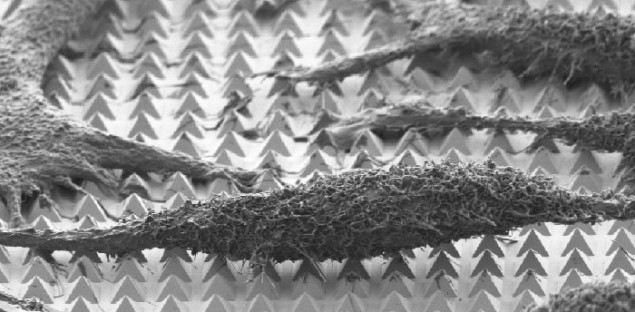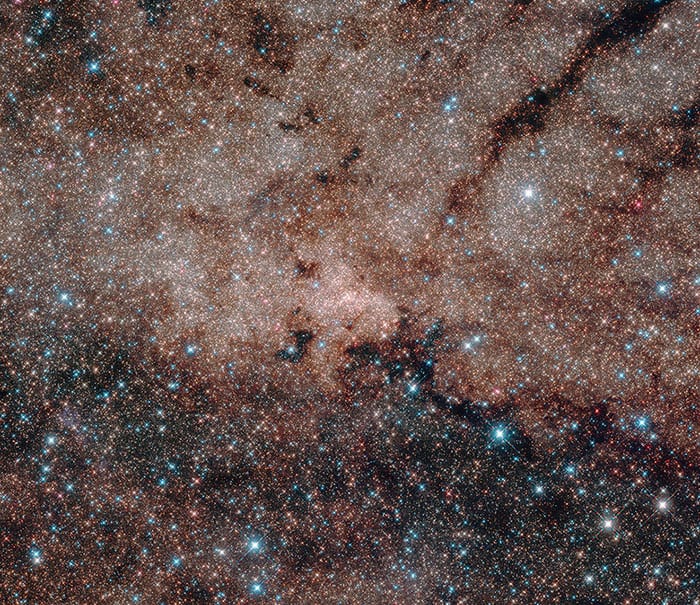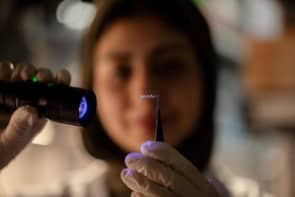Flash Physics is our daily pick of the latest need-to-know developments from the global physics community selected by Physics World‘s team of editors and reporters

Golden pyramids deliver drugs to living cells
Tiny pyramids activated by laser pulses can temporarily pierce cells to allow drug delivery. Nabiha Saklayen of Harvard University in the US and colleagues have used a technique called “template stripping” to create surfaces textured with about 10 million microscale pyramids. The process involved a reusable silicon “master template” containing millions of inverted, ordered pyramids (rather like a pyramid ice-cube tray). This template was coated with 50 nm of gold, filled with UV glue and then topped with a coverslip. Once cured, these layers could be peeled off, resulting in a surface covered in micro-pyramids. The team cultured HeLa cancer cells on the pyramids and surrounded the cells with a solution containing molecular cargo. As Saklayen and collaborators have previously shown that small arrays of gold micro-pyramids can focus laser energy into electromagnetic hotspots, they applied nanosecond laser pulses to the pyramid-cell system. While the cells were not affected, the laser pulses caused the pyramid tips to reach about 300 °C. This localized heating produced bubbles that gently pushed their way through the cells’ protective membranes, opening pores that allowed molecules to diffuse into the cell. “We found that if we made these pores very quickly, the cells would heal themselves and we could keep them alive, healthy and dividing for many days,” Saklayen explains about the study published in ACS Nano. Controlling the laser parameters meant the researchers could control the bubble formation and hence the cell penetration. “Being able to effectively deliver large and diverse cargos directly into cells will transform biomedical research,” Saklayen continues. “This work is really exciting because there are so many different parameters we could optimize to allow this method to work across many different cell types and cargos. It’s a very versatile platform.”
NASA goes for GUSTO balloon mission

NASA has given the green light to the balloon-borne GUSTO terahertz observatory that will map and measure emissions from the interstellar medium. The $40m mission is scheduled for launch in 2021 from the McMurdo research station in Antarctica and will last 100–170 days, depending upon weather conditions. The balloon will carry a spectroscopic telescope that will detect emission lines from carbon, oxygen and nitrogen, with the aim of shedding light on the life cycle of the gas found in the regions between stars in the Milky Way and a nearby galaxy called the Large Magellanic Cloud. “GUSTO will provide the first complete study of all phases of the stellar life cycle, from the formation of molecular clouds, through star birth and evolution, to the formation of gas clouds and the re-initiation of the cycle,” says NASA’s Paul Hertz. GUSTO will be part of NASA’s Explorers Program of smaller-scale missions.
Magnons spotted in non-magnetic phase of material
Magnons have been measured for the first time in the non-magnetic phase of a material, answering a long-standing question in condensed-matter physics. The magnetic spins in a ferromagnetic material tend to point in the same direction, creating a net magnetization. Magnons are collective excitations whereby the directions of some of the spins oscillate around the magnetization direction. A long-standing mystery about magnons is what happens to them when a magnet is heated up through the Curie temperature – above which the magnetic spins cease to point in the same direction and instead point in random directions. Naively, one might assume that magnons cannot exist in this non-magnetic phase because there is no magnetization to oscillate about. However, spins can align over short distances in this phase, opening the door to magnons. Now, Khalil Zakeri and colleagues at the Karlsruhe Institute of Technology have found the first evidence for magons above the Curie temperature of a material. They studied a thin film of iron and palladium with the relatively low Curie temperature of 380 K – which makes it easier to identify magnons. They fired a beam of spin-aligned electrons at the material, which was subject to a magnetic field. Below the Curie temperature, magnons absorb energy from the beam when the spin of the electrons is in the opposite direction to the magnetization of the sample. As they increased the temperature to above 380 K, they found that this absorption occurred well into the non-magnetic phase of the material. While the magnons were significantly weaker abovee the Curie temperature, they were able to propagate nearly 3 nm through the material. The study is described in Physical Review Letters.
- You can find all our daily Flash Physics posts in the website’s news section, as well as on Twitter and Facebook using #FlashPhysics. Tune in to physicsworld.com later today to read today’s extensive news story on how bees navigate using magnetic fields.



